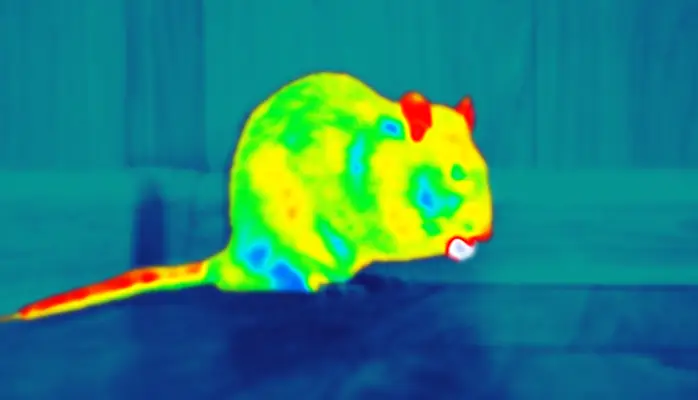Firstly I’ll say that Pestology don’t use IR cameras in any aspect of their diagnostics and therefore that pretty much summarises our opinion of its role in this game – none!
However many other companies do and we get asked about it a lot so it’s important to fully understand what it is, how it works and how its ended up in the pest control industry.
IR cameras detect thermal shifts (i.e. contrasts of hot and cold) and display these as a multi-coloured image – red is hot, orange is warm, yellow/green is average and then blue/purple/black is the cold side of things.
Not surprisingly IR cameras are therefore most widely used in the construction industry to detect heat leaks in buildings – i.e. cold spots in hot places.
However its technology that’s also used by other industries for finding hot things in cold places and probably the most widely aware usage is within the ‘Police, Camera, Action!’ type of documentaries where the police helicopter finds the sweaty car thief hiding in a cold bush in the middle of the night using IR.
Other classic usage of IR is the ‘Predator’ films of the 90’s – again the alien spots the sweating humans amongst the cool jungle foliage but then Arnie rubs himself in mud to block the body heat and become invisible!
Great sci-fi stuff that really grabs the imagination and it’s easy to see why people who were around in the 90’s then think an IR camera off the internet is going to show hiding rats behind walls and allow the user to casually inspect their movement (just like I saw on TV right?).
What people aren’t aware of is that IR technology at this level is seriously expensive – way, way above what gets used in the construction industry or that is generally available to the man in the street.
What happens if you point a standard IR camera at a wall is that you generally just get a smudge of colour – essentially the plasterboard/brickwork etc. blocks out/dumbs down whatever is hot & cold behind it in the same way that you can’t really hear the lyrics of the loud music the neighbours play through the party wall (just feel the base & beats).
We’ve experimented with IR cameras of all flavours a lot over the years and concluded that at very best you may just get enough of a thermal shift to determine the cold spot produced by a rat burrow through a layer of cavity wall insulation.
What does that tell you? That there are rats tunnelling through the insulation within a wall cavity.
Where are they tunnelling from? Either the bottom or the top.
And that’s about it in terms of feedback for any particular survey – yes there look to be rats within the building fabric (which you probably already knew) but still no idea where how they are actually entering the building fabric in the first place.
But people love hi-tech solutions and the allure of IR with its NASA pretences means the pest control industry (amongst others) have essentially hijacked it purely for the purpose of making sales.
It’s a tempting bait that many fish out there will swallow especially if they’ve been battling with an unresolved rat problem for many years and are getting desperate.
But it’s purely a gimmick and won’t help you make any ground with your rat problem – I would be wary of anyone offering it!
So here’s a secret from Pestology that comes from a more grounded perspective…. Rats generally get into a building from the waste system.
If the waste system is 100% integral then the rats stay in it and all is well.
However if the waste system has any defects then the rats have the opportunity to move between pipe and building fabric should the defect be close or under the building.
You therefore need to understand the waste system and the construction of any given building first to establish points of liability – you then need to know how rats behave/what they are capable of in order to weight the established points of liability.
That’s logic right there – no science, no helicopters and no aliens.


